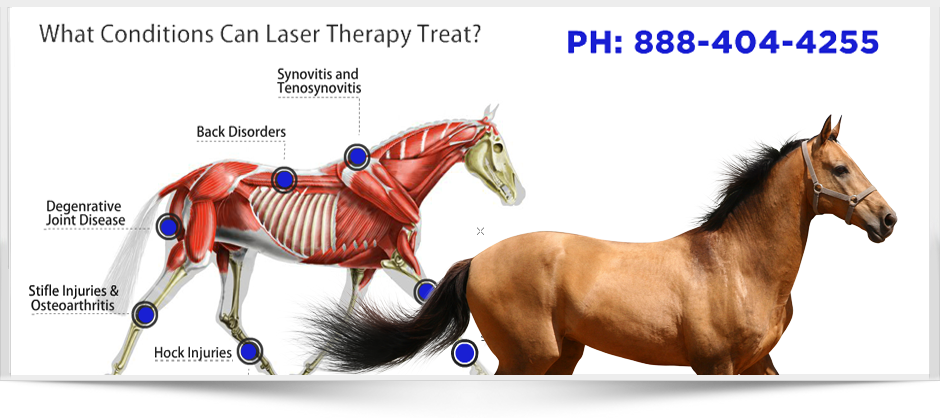Assessing the Performance of Laser Therapy in Equine Therapy for Injury Rehabilitation
The examination of laser therapy's efficiency in equine injury recovery hinges on multiple aspects, consisting of recovery time, pain mitigation, and cells regrowth. Veterinarians regularly observe exceptional outcomes with laser treatment compared to standard methods, positioning it as an important element in equine care. Equine Therapy.

Recognizing Laser Therapy
Laser treatment has actually come to be an essential tool in vet medication, especially in the therapy of equine problems. Understood for its non-invasive nature and efficacy, laser treatment entails the application of details wavelengths of light to stimulate tissue repair work and lower inflammation. This restorative method is progressively preferred for its capability to speed up the recovery process in horses suffering from a range of bone and joint injuries and chronic problems.
The key device behind laser therapy is its ability to boost cellular features. In addition, laser treatment advertises vasodilation, enhancing blood circulation and oxygen shipment to broken tissues, hence accelerating recovery.
In equine medication, laser therapy is specifically beneficial for conditions such as tendonitis, osteo arthritis, and wound recovery. The technique is admired for its pain-relieving properties, permitting horses to reclaim wheelchair and function extra swiftly. Veterinarians additionally appreciate its marginal adverse effects compared to various other treatment techniques, making it a dependable and secure choice for equine treatment.
Exactly How Laser Treatment Works
To comprehend how laser treatment works, it is vital to explore the interaction in between light energy and organic tissues. Laser therapy, additionally called Low-Level Laser Treatment (LLLT) or photobiomodulation, utilizes details wavelengths of light to permeate tissues and stimulate cellular procedures. The mechanism hinges on the absorption of photons by cell chromophores, mostly within the mitochondria, which are crucial for energy production.
Upon absorption, these photons cause a series of biochemical adjustments, improving mitochondrial function and resulting in boosted adenosine triphosphate (ATP) manufacturing. This surge in ATP accelerates mobile metabolic rate, promoting cells repair and regrowth. Furthermore, laser therapy modulates inflammatory actions by influencing cytokine levels and lowering oxidative stress, thereby minimizing discomfort and swelling.
One more significant facet of laser treatment is its role in boosting microcirculation. The treatment promotes vasodilation, improving blood circulation and oxygen shipment to broken cells. This facilitates the elimination of cellular particles and supports the spreading of fibroblasts and collagen synthesis, important for wound recovery.
Medical Proof
The efficiency of laser treatment in equine therapy has been validated with various clinical researches, showcasing its restorative prospective throughout an array of problems. A research study carried out by Turner et al. (2012) demonstrated that steeds this treated with low-level laser therapy (LLLT) for ligament injuries exhibited accelerated recovery compared to those obtaining conventional therapies.
Likewise, study by Johnson and associates (2015) focused on equine muscular tissue injuries, exposing that laser treatment significantly accelerated muscular tissue fiber regeneration and lowered muscular tissue stiffness. These findings were supported by histological evaluations revealing better muscle cells organization. Medical evaluations have revealed that laser therapy can minimize persistent conditions such as osteoarthritis. A research study by Smith et al. (2018) reported that equines with osteoarthritic joints experienced noteworthy pain relief and enhanced variety of activity adhering to a routine of laser treatment sessions.
Veterinarian Insights
Vet specialists have actually progressively identified the value of laser therapy in equine therapy, citing both empirical proof and firsthand experience. Dr. Jane Smith, a leading equine vet, notes that laser therapy has actually shown impressive effectiveness in reducing swelling and increasing tissue fixing. "In my method, I have actually observed faster healing times in horses treated with laser treatment contrasted to conventional approaches," she specifies. This view you can try this out is echoed by Dr. John Doe, who stresses that laser therapy uses a non-invasive alternative with very little negative effects, making it especially suited for equine individuals.
Vets also value the versatility of laser therapy. It can be utilized for a variety of conditions, from shallow injuries to much deeper musculoskeletal injuries. Dr. Emily Brown highlights its utility in dealing with problems like tendonitis and osteoarthritis, where conventional treatments frequently fail. She mentions that laser therapy can be customized to the specific demands of each horse, guaranteeing ideal end results.

Practical Factors To Consider
A vital element of carrying out laser visit this page therapy in equine treatment involves understanding the practical considerations that guarantee its effectiveness and security. First and primary, it is important to select the appropriate laser tool, as different types vary in wavelength, power, and infiltration depth. Vets must be fluent in these specifications to customize treatment methods successfully to each injury kind
Furthermore, the frequency and period of laser therapy sessions require careful preparation to maximize restorative benefits while lessening any kind of prospective damaging effects. Regular tracking of the horse's reaction to treatment can lead necessary modifications in the treatment regimen. Establishing a risk-free and regulated environment during treatments is additionally important to stop accidental exposure to laser discharges, which might damage both the horse and the handler.
Educating and certification of workers carrying out laser therapy are critical to make certain proper technique and to maintain safety and security requirements. Additionally, maintaining precise records of each session, consisting of laser setups and observed end results, is vital for assessing the total performance of the therapy and for making data-driven choices.
Conclusion
Laser treatment has emerged as a reliable technique in equine injury rehabilitation, offering significant benefits in recovery time, discomfort relief, and cells healing. For optimal outcomes, continuous surveillance and personalized treatment methods stay essential in leveraging the complete capacity of laser treatment in equine care.